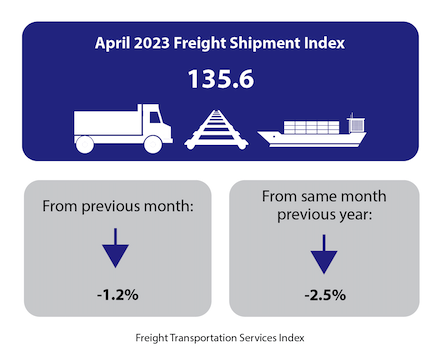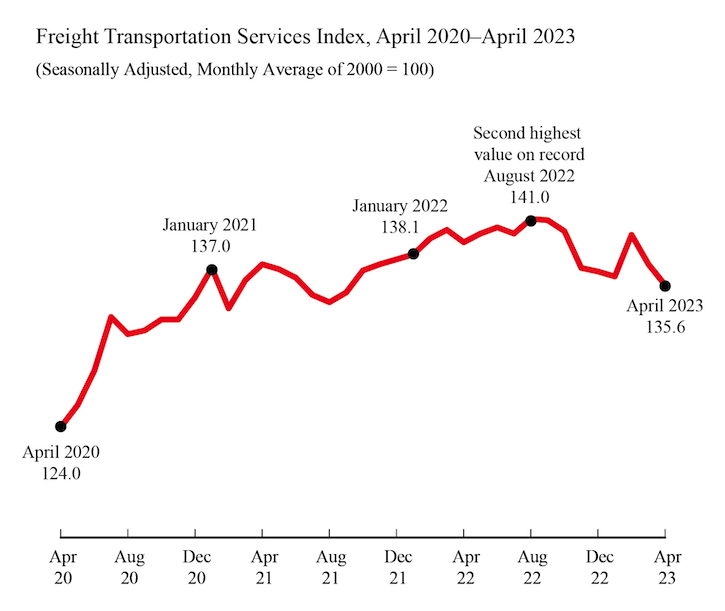
The Freight Transportation Services Index (TSI), which is based on the amount of freight carried by the for-hire transportation industry, fell 1.2% in April from March, falling for the second consecutive month, according to the U.S. Department of Transportation’s Bureau of Transportation Statistics’ (BTS). From April 2022 to April 2023 the index fell 2.5%.

The level of for-hire freight shipments in April measured by the Freight TSI (135.6) was 4.0% below the all-time high level of 141.2 in August 2019 (Table 2A). BTS’ TSI records begin in 2000.
BTS is withholding the scheduled release of the passenger and combined indexes for April, because air passenger travel continues to deviate from regular seasonal patterns, as it adjusts to the effects induced by the COVID-19 pandemic. Air freight for April and waterborne for March and April are also statistical estimates. Since air freight and waterborne make up a smaller part of the freight index, the freight TSI is being released as scheduled with the air freight estimate included.
The Freight TSI measures the month-to-month changes in for-hire freight shipments by mode of transportation in tons and ton-miles, which are combined into one index. The index measures the output of the for-hire freight transportation industry and consists of data from for-hire trucking, rail, inland waterways, pipelines and air freight. The TSI is seasonally-adjusted to remove regular seasonal movement, which enables month-to-month comparisons.
Analysis: The Freight TSI decreased in April due to seasonally adjusted decreases in rail carload, water, air freight, pipeline, and trucking, while rail intermodal grew.
The April decrease came in the context of growth for several other indicators. The Federal Reserve Board Industrial Production (IP) Index was up 0.5% in April, reflecting increases of 0.6% in mining and 1.0% in manufacturing while utilities were down 3.1%. Housing starts were up 2.2% while personal income increased by 0.4%.
The Institute for Supply Management Manufacturing (ISM) index was up 0.8 points to 47.1, indicating stabilization in manufacturing.
Although the April Passenger TSI is being withheld because of the previously cited difficulty of estimating airline passenger travel and other components, the March index is now being released. The index decreased 1.3% from February to March. Seasonally adjusted transit, rail passenger and air passenger all decreased.
The Passenger TSI has now exceeded its level in March 2020 —the first month of the pandemic— for 22 months in a row but remains below its pre-pandemic level (February 2020) for the 37th consecutive month.
Trend: The April freight index decrease was the second consecutive, leaving the index 2.9% below the February level. This was the eighth decrease in ten months, for an overall decrease of 3.3% since June 2022. It was the 9th month-over-month decrease in 20 months, for a total increase of 1.0% since August 2021. The April Freight TSI is 9.4% above the pandemic low in April 2020; it has increased in 20 of the 36 months since that low. The index is now 4.0% below its previous record level of 141.2 set in August 2019, despite increasing in 20 of the 44 months since that earlier peak.
Index highs and lows: For-hire freight shipments in April 2023 (135.6) were 42.7% higher than the low in April 2009 during the recession (95.0). The April 2023 level was 4.0% below the historic peak reached in August 2019 (141.2).
Year to date: For-hire freight shipments measured by the index were down 0.8% in April compared to the end of 2022.
Long-term trend: For-hire freight shipments are up 0.1% in the five years from April 2018 and are up 17.9% in the 10 years from April 2013.
Same month of previous year: April 2023 for-hire freight shipments were down 2.5% from April 2022.
The TSI has three seasonally-adjusted indexes that measure changes from the monthly average of the base year of 2000. The three indexes are freight shipments, passenger travel and a combined measure that merges the freight and passenger indexes. TSI includes data from 2000 to the present. Release of the May 2023 index is scheduled for July 13, 2023.
Revisions: Monthly data has changed from previous releases due to the use of concurrent seasonal analysis, which results in seasonal analysis factors changing as each month’s data are added.
BTS research has shown a clear relationship between economic cycles and the Freight and Passenger Transportation Services Indexes.







